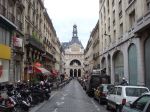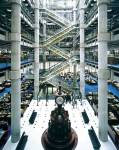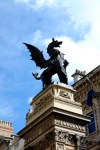It was Queen Elizabeth who brought down the world economy when she hand-picked Maragaret Thatcher because she was at the head of Britian’s evangelical nut-jobs who were hell-bent to destroy Beetlemania that brought down the Soviet Union and the Berlin Wall. Thatcher ‘The Deregulator’ made a allience with Reagan and the Bush Presidents to Privatize the world, take monies from secular Governments and give it to the filthy rich – who back the Christian-right and the Tea Baggers – who are in the back pocket of British Bankers.
Lloyd’s of London bought a mountain of bad bundled loans made in America by ministers of the Prosperity Gospel who had to give their flock a pay day, and thus encouraged them to buy homes they could ill afford. The Rouge Dragon fleeced the sheep of the Corporate Jesus.
Here is Kim Richardson, the son of Sir Michael Richardson de Rougemont, a Freemason whose Huguenot kinfolk, the De Rougemonts founded Lloyd’s of London. A Rougemont Huguenot is possibly the progenitor of the Rosamond family.
Jon Presco
http://www.realca.co.uk/video/kim_richardson.wmv”
“CHARTIER Catherine married in 1480 OF the TEMPLE Jean IV
prosecutorin l? officiality of Chartres, lord of Brerville, expert in Chartres, descendant of, Geoffroi of the TEMPLE, Banker of king Philippe the Bold one and Jean 1° its son, secretary of the commands of kings Philippe Length and Charles the Beautiful one.”The Du Temple de Rougemont family came originally from the city of Chartres, in the
Beauce region south-west of Paris, and were noted in the city records as early as 1285. They were simply called “du Temple” at that time, and were not noble or “armigerous” (arms-bearing) until around 1500.
They did not become “du Temple de Rougemont” until 1672, when the lawyer Guy-Charles du Temple, native of Chartres, married Francoise-Nicole de Boisrouvray, the heiress of an estate called Rougemont, also in the Beauce region. The name du Temple suggests this family is connected with the Knight Templars in some way. The Chartier were bankers to kings, and were well connected in Chartes and to its famous cathedral the Templars allegedly built. Today in Britian ‘Of
the Temple’ denotes one is a lawyer, or barrister. Allegedly the Templars turned of their grounds incorporated into the ‘City of London’ to lawyers
Abram Denis Alfred de Rougemont of Neuenburg, is the Paris banker whom the street Rue Rougemont is named after and is mentioned by Engels alongside the Rothschild family in regards to the Paris Stock Market. I suspect Abram is related to Denis de Rougemont who was also born in the Neuenburg (Newenberg) area of Neufchatel. The likelyhood Herbert de Rougemont of Lloyd’s is related to this Rougemont banker, is high. There is may be some confusion about who Arthur Mallet married, he from another famous Huguenot banking family. Denis de Rougemont (* 8. September 1906 in Couvet, Kanton Neuenburg; The castle, a smaller replica of the château of Azay-le-Rideau on the Loire, was built in 1852 for the de Rougemont family of Neuchâtel.
Build 1846-54 after plans of Pierre Charles Dusillon for the
Neuenburger Banquier Abraham Denis Alfred de Rougemont.
RGB is a managing agency and presently manages five syndicates operating in the Lloyd’s of London (“Lloyd’s”) insurance market. In November 1997, RGB Holdings, Ltd. acquired 100% of C.I. de Rougemont Group Limited, the ultimate holding company for C.I. de Rougemont &
Co. Ltd. (“CIDR”), another Lloyd’s managing agency.””Lloyd’s were able to persuade Mr Grech to agree that, in future, he would perform salvage services on the terms of a contract which provided for arbitration in London by the Committee or an arbitrator appointed by the Committee, if there was any subsequent objection to the lump sum figure in the contract. However the contract wording agreed with Mr Grech stipulated that the lump sum had to be paid to Mr Grech in the
first instance on termination of the services.This arrangement with Mr Grech was approved by the Committee of Lloyds when it met on 25th June 1890 and was quickly brought into effect. Following the successful salvage by Mr Grech of the vessel “HELEN OTTO” there was an objection to the price agreed with him and, in November 1890, the Committee referred the matter to a sub-Committee, comprising a Mr
Hardy and a Mr de Rougemont. Their report was considered at the Committee meeting on 26th November 1890 and it was resolved that the agreed price of £950 should not be disturbed.”
George de Rougemont: “In 1791, it travels to England where it returns visit to his established banking brothers to London.””Although it had originally operated from offices in the Palais-Royal, in 1851 the CNEP took out a lease on the Hôtel Rougemont (the residence and offices of the banker Rougemont) and transferred its head office to 14 rue Bergère.””Here, too dwell the great bankers of the rues
Laffitte and Bergère and also the merry gentlemen of private means of the chaussée d’Antin. Rothschild and Fould, Rougemont de Lowemberg and Ganneron live here. In a word, here lies the Stock Exchange, Tortoni[103] and all that is connected with or dependent on them.”
Arthur Mallet b. 1821 d. 1891 & Anna de Rougemont de La Schadau Arthur MALLET est né le 21.01.1821 à Paris. Il est lui aussi banquier. Il épouse le 04.04.1847 à Paris 1er, Sophie Denise Anna du TEMPLE de ROUGEMONT. Il décède le 12.01.1891 et Anna le 22.05.1896, tous deux à Paris.
Sir Michael Richardson
Banker who advised Thatcher on her privatisation programme, but ended his career with a lifetime ban from City
ONCE KNOWN as “Mr Privatisation”, Sir Michael Richardson flew as high as any in the City during a 50-year banking career, working for the glittering names, advising Chancellors and Prime Ministers, and himself enjoying virtually celebrity status. And then in 2001 he was banned for life from doing business in the City “in any capacity”.
When Sir Evelyn de Rothschild recruited Richardson to be managing director of the merchant bank N. M. Rothschild in 1981, the chairman of rivals S. G. Warburg said it was the worst news he had had for a year. And Richardson soon showed why. Within a couple of months Rothschild was handling its first new issue for seven years, and the bank was beginning a period of domestic and international growth.
It was a propitious moment. Margaret Thatcher was embattled in her early and massively unpopular attempts to freeze the money supply, liberalise markets and remove the union noose from the necks of business. But by the time Richardson had arranged all the hunting prints and paintings in his plushly, pinkly carpeted office at Rothschilds, victory in the Falklands had given her the electoral security to push through a programme of privatisations that even she had not dared dream of when she first entered No 10.
Privatisations such as the gas, water and electricity industries, and the Big Bang in the City, would make Rothschilds several new fortunes, win Thatcher the gratitude of millions of small investor-voters, and turn Britain from the sickest to the healthiest of the European economies. As one of the chief deal- makers during these sell-offs, Richardson was intimate with the whole process.
Although he did not always concern himself with logistics — he had teams of people to worry about those — he became Thatcher’s favourite banker thanks to his support for her vision, his indeflectible outlook and his knowledge of how to gain the co-operation of the City. And as with most of Thatcher’s coterie of advisers in various fields, the admiration was mutual. “She has been a truly great Prime Minister,” Richardson said in 1990. “She has done more for the City and the country by creating free markets than anyone.”
Richardson’s zesty attitude to doing deals was similar to Thatcher’s attitude to running the country. He worked hard — usually at his desk by 8am — and followed his principles, but it had to be enjoyable too. So there were visits to the opera with the Thatchers, and one year the Richardsons spent Boxing Day at Chequers.
But as well as friendships with Cabinet Ministers such as Peter Walker, who organised the flotation of British Gas in 1986, Norman Lamont and other political standard bearers, Richardson’s charm and joie de travailler won him the personal loyalty of important private clients such as Lord King, with whom he had served in the Army in Palestine.
Another lucrative client was Lord Hanson, whom Richardson advised on the ballooning takeovers of London Brick in 1984 (£254 million), Imperial Group in 1986 (£2.6 billion) and, appropriately, Consolidated Gold Fields in 1989 (£3.5 billion). Richardson was also a friend of Asil Nadir, though his colleagues were more cautious than he about dealing with the proprietor of Polly Peck.
Born in London in 1925, the eldest of three sons, Michael John de Rougement Richardson had a solidly upper-class education at Harrow and then Kent School in Connecticut. Then, in 1943 he was commissioned in the Irish Guards. Though twice wounded, he became adjutant to the First Battalion, and was demobbed as a captain.
A flirtation with Cambridge quickly showed that the academic life was not for him, and in 1949 he began work for Harvey Drayton, working in the investment trust business for three years.
His true career began, however, when he joined Panmure Gordon as a junior partner in 1952. It was there that he first came across Robert Maxwell, when the firm acted in the flotation of Pergamon Press. Richardson claimed that they were not friends, but quarter of a century later, this time at Rothschilds, he acted again for Maxwell, whose Mirror Group he brought to market in 1991, and whose empire he tried to save, before it went belly-up in the Atlantic. Richardson was one of the first people telephoned by Kevin Maxwell when the news of his father’s disappearance came through, and he handled the request to the Stock Exchange to suspend the shares.
Richardson’s 19 years at Panmure Gordon were spent building a network of contacts, not least over lunches at the Savoy, where he was a director, and through the ultimate clique, the freemasons. In 1971 he moved to the stockbrokers Cazenove, and there — under his mentor Luke Meinertzhagen — he took part in important events such as the first sale of BP state shares, and relished battles such as the epic Grand Metropolitan/Watneys takeover, and the House of Fraser’s defence against the Lonrho takeover bid.
With his love of gossip, Richardson was a favourite with City editors, though he was sometimes over-optimistic about his own successes. The partners at Cazenove, that smoothest and most discreet of institutions, feared that he dropped rather too many names, and lived rather too flamboyantly, and the senior partnership did not come his way.
So the move to Rothschilds as managing director, 1981-90, suited him perfectly, giving him a vehicle for his energetic wheeler-dealing. He is said to have generated more fees in the state sell-offs than any other adviser, leading to a knighthood on his retirement from the firm in 1990. But at 65, perhaps unwisely, he had not had enough.
He became chairman of the stockbrokers Smith New Court for four years, and remained a consultant there for a further two. The results were once again impressive, with Smith New Court enjoying growth in its overseas business and becoming broker to four FTSE 100 stocks. However, the years of high Thatcherism and Richardson’s political influence were waning (dealing with John Major was a different matter, he found), and all the while the rules of the City were tightening, the way of doing business was changing, and his grasp of details was becoming weaker.
In 1996 Richardson moved again, to work for Hawkpoint Partners, an investment boutique then owned by NatWest. It was there that he wrote a series of letters on behalf of an acquaintance, Alan Shephard, which declared that credit of “up to $350 millions” would be available. Shephard, however, had twice been declared bankrupt, and in 2001 the Securities and Futures Authority decided that Richardson had been reckless in providing letters that might have been used in an advance fee fraud — a kind of money laundering.
Although Richardson had left Hawkpoint in 1999, the SFA found that he was no longer a fit and proper person to be working in the City. It accepted that he had not been dishonest or written the letters for personal gain, but said that he had ignored all modern compliance procedures. He had just happened to like Shephard. “I believed in him,” he said.The lifetime ban was perhaps rather an academic matter for a man of 76, but he was also ordered to pay £85,000 costs.
Richardson, who lived on the Isle of Wight, was a keen sailor, and a member of the Royal Yacht Squadron at Cowes. As joint master of the Crawley and Horsham hunt, he was passionate about foxhunting, and never gave up the campaign for its continuance.
Michael Richardson married Octavia Mayhew (known as Paddy) in 1949, and was radiantly happy with this “most enchanting woman” for half a century until her death in 1999. He is survived by their son and two daughters.
Sir Michael Richardson, banker, was born on April 9, 1925. He died on May 12, 2003, aged 78.




Leave a comment